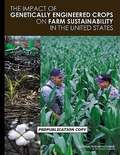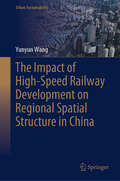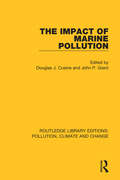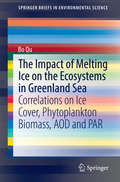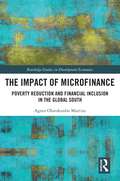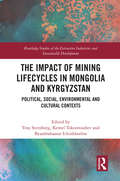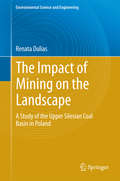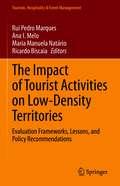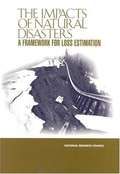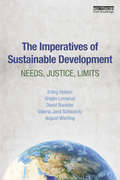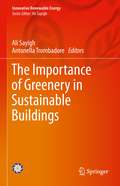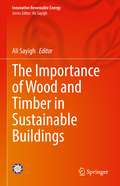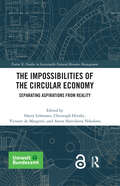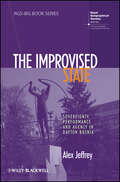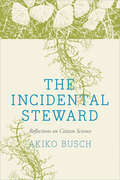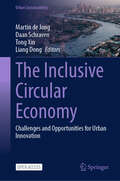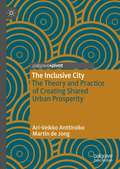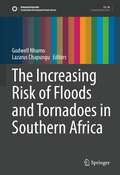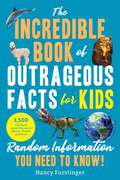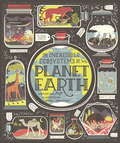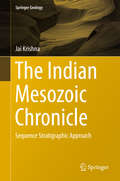- Table View
- List View
The Impact of Genetically Engineered Crops on Farm Sustainability in the United States
by National Research Council of the National AcademiesSince genetically engineered (GE) crops were introduced in 1996, their use in the United States has grown rapidly, accounting for 80-90 percent of soybean, corn, and cotton acreage in 2009. To date, crops with traits that provide resistance to some herbicides and to specific insect pests have benefited adopting farmers by reducing crop losses to insect damage, by increasing flexibility in time management, and by facilitating the use of more environmentally friendly pesticides and tillage practices. However, excessive reliance on a single technology combined with a lack of diverse farming practices could undermine the economic and environmental gains from these GE crops. Other challenges could hinder the application of the technology to a broader spectrum of crops and uses. Several reports from the National Research Council have addressed the effects of GE crops on the environment and on human health. However, The Impact of Genetically Engineered Crops on Farm Sustainability in the United States is the first comprehensive assessment of the environmental, economic, and social impacts of the GE-crop revolution on U.S. farms. It addresses how GE crops have affected U.S. farmers, both adopters and nonadopters of the technology, their incomes, agronomic practices, production decisions, environmental resources, and personal well-being. The book offers several new findings and four recommendations that could be useful to farmers, industry, science organizations, policy makers, and others in government agencies.
The Impact of Global Warming on Texas
by Jurgen Schmandt Gerald R. North Judith ClarksonOverall, this book is an admirable attempt at a discussion of the effects of global warming, and should stimulate discussions of policy options at the state, and even national, level. . . . This thought-provoking book is suitable for environmental decisionmakers in Texas (or in any state) who are trying to deal with global climate change. The book is ideal for supplementing college classes in environmental management and policy. --Science Books and Films This is the most wide-ranging, integrated analysis of climate change impacts on a region that I have seen. . . . it should be read carefully by anyone attempting to assess what climate change means for their region. --William E. Riebsame, associate professor of geography, University of Colorado, Boulder The presence of uncertainty need not immobilize us like a deer trapped in the headlights of an onrushing truck. There is enough information to craft a sound program for a rational response to climate change in Texas. So concludes this report of the Task Force on Climate Change in Texas, an interdisciplinary group of experts convened to study the possible effects of global warming on Texas and to identify policy options for avoiding or mitigating them. After introductory chapters on global climate change, the changing Texas climate, and greenhouse emissions, individual chapters of this study explore the effects of global warming on Texas water resources, estuaries, biodiversity, agriculture, urban areas, and the economy. These essays reveal a wide range of possible effects, from severe stresses on water and coastal resources to low impact in the agricultural sector and in urban areas. Policy options for reducingemissions and mitigating some of their effects are included. Gerald R. North is a distinguished professor of meteorology and oceanography at Texas A & M University. Jurgen Schmandt is director of the Center for Global Studies of the Houston Advanced Research Center and a professor of public affairs at the University of Texas at Austin. Judith Clarkson is a consultant to the Center for Global Studies.
The Impact of High-Speed Railway Development on Regional Spatial Structure in China (Urban Sustainability)
by Yunyun WangUsing the theoretical framework of new economic geography and the research methods of GIS and econometrics, this book analyzes the impact of high-speed railway development on China's economic distribution, population mobility and regional integration. The development of high-speed railway has subverted the traditional mode of transportation, greatly shortened the time and space distance between cities, and people's travel patterns, employment choices and production behaviors have undergone profound changes accordingly, which has had an increasing impact on economic and social development. The findings of this book have important theoretical and practical significance for China's transportation infrastructure construction and regional spatial development. The book is intended for researchers in urban planning, economics, geography and readers interested in regional spatial development in China.
The Impact of Marine Pollution
by Douglas J. Cusine and John P. GrantOriginally published in 1980, this book by a group of international lawyers and experts from the energy industries suggests ways in which the law may have to change to cope with developments in the oil and nuclear energy industries and the way they impact on marine pollution. Incorporating issues arising on an international and comparative basis, the book discusses the approaches made to marine pollution problems by the UK, EU and USA.
The Impact of Melting Ice on the Ecosystems in Greenland Sea
by Bo QuArctic marine ecosystems are largely impacted by changes associated with global warming. The sea ice in Greenland Sea plays an important role in regional and global climate system. The book investigate the relationships between phytoplankton biomass, measured using remotely sensed chlorophyll-a (CHL), aerosol optical depth (AOD) and sea-ice cover (ICE) in the Greenland Sea (20°W-10°E, 65-85°N) over the period 2003-2012. First hand Satellite data was used to do correlation analysis. Enhanced statistics methods, such as lag regression method and cointegration analysis method are used for correlation and regression analysis between 2 variables (up to 3 variables). ARMA model was used to prediction time series in the future 3 years. The book not only gives outline of ecosystem in Greenland Sea, how the ice impact to the local ecosystems, but also provides valuable statistical methods on analysis correlations and predicting the future ecosystems.
The Impact of Microfinance: Poverty Reduction and Financial Inclusion in the Global South (Routledge Studies in Development Economics)
by Agnes Olatokunbo MartinsHistorically, microfinance has emerged as a means to extend financial services to previously excluded populations, serving as a pathway to poverty reduction and aligning with Sustainable Development Goal 1: End poverty in all its forms everywhere. This book argues that microfinance plays a crucial role in achieving financial inclusion, significantly enhancing economic welfare, and reducing poverty in developing countries.It highlights the necessity to rigorously address issues such as mission drift, macroeconomic stability, governance, regulatory frameworks, and enforcement. It provides a contemporary and comprehensive overview of microfinance implementation in developing countries, enabling comparative analysis of regulatory and supervisory practices, and evaluates theoretical frameworks linking microfinance to economic growth and poverty reduction, utilising concepts of financial intermediation, resource allocation, and financial development. The book empirically tests the causal relationships between microfinance, economic growth, and poverty reduction using a balanced panel dataset of macroeconomic and microeconomic indicators and identifies and analyses the mechanisms through which microfinance impacts economic welfare and poverty reduction. As well as asking whether microfinance can alleviate multidimensional poverty in favourable macroeconomic, political, and business environments in developing countries, it also questions whether it enhances living standards, health, and education. It examines how economic shocks impact vulnerable populations and microfinance institutions and looks at the factors that contribute to the success of microfinance in countries where it is well-established. Further, it offers policy implications and recommendations to enhance the effectiveness of microfinance and address key challenges.This book targets a broad spectrum of readers involved in microfinance, financial inclusion, and development economics, including researchers, academics and students as well as policymakers and government officials.
The Impact of Mining Lifecycles in Mongolia and Kyrgyzstan: Political, Social, Environmental and Cultural Contexts (Routledge Studies of the Extractive Industries and Sustainable Development)
by Troy SternbergThis volume investigates how mining affects societies and communities in Mongolia and Kyrgyzstan. As ex-Soviet states, Mongolia and Kyrgyzstan share history, culture and transitions to democracy. Most importantly, both are mineral-rich countries on China’s frontier and epi-centres of resource extraction. This volume examines challenges communities in these countries encounter on the long journey through resource exploration, extraction and mine closure. The book is organised into three related sections which travel from mine licensing and instigation to early anticipation of benefit through the realisation of social and environmental impacts to finite issues such as jobs, monitoring, dispute resolution and reclamation. Most originally, each chapter will include a final section entitled ‘Notes from the Field’ that presents the voice of in-country researchers and stakeholders. These sections will provide local contextual knowledge on the chapter’s theme by practitioners from Mongolia and Central Asia. The volume thereby offers a distinctively grounded perspective on the tensions and benefits of mining in this dynamic region. Using Mongolia and Kyrgyzstan as case studies, the volume reflects on the evolving challenges communities and societies encounter with resource extraction worldwide. The book will be of great interest to students and scholars of mining and natural resource extraction, corporate social responsibility and sustainable development.
The Impact of Mining on the Landscape
by Renata DuliasThis book investigates the Upper Silesian Coal Basin (USCB), one of the oldest and largest mining areas not only in Poland but also in Europe. Using uniform research methods for the whole study area, it also provides a summary of the landscape transformations. Intensive extraction of hard coal, zinc and lead ores, stowing sands and rock resources have caused such extensive transformations of landscape that it can be considered a model anthropogenic relief. The book has three main focuses: 1) Identifying anthropogenic forms of relief related to mining activity and presenting them from a spatial, genetic and age perspective; 2) Determining the changes in the morphometric characteristics of relief and the conditions for matter circulation in open systems (drainage basins) and closed systems (land-locked basins) caused by the extraction of mineral resources; and 3) Estimating the extent of anthropogenic denudation using two different methods based on raw-material output and morphometric analysis. In Poland, no other mining area has undergone such intensive mining activity as the Upper Silesian Coal Basin during the last half century. Its share in the total extraction of mineral resources was as high as 32%. The total extraction of hard coal in the Upper Silesian Coal Basin from the mid-18th century until 2009 was the sixth largest in the world, and the permanent, regional effects of mining anthropopressure on the relief are among the most severe in the world. The anthropogenic denudation rate in the Upper Silesian Coal Basin, as well as the Ruhr Coal Basin (Ruhr District) and the Ostrava-Karvina Coal Basin, ranges from several dozen up to several hundred times higher than the rate of natural denudation, irrespective of the calculation method used. It would take the natural denudation processes tens of thousands of years to remove the same amount of material from the substratum as that removed through human mining activity.
The Impact of Networks on Unemployment
by J. M. HurstThis book investigates why networks, some with joined-up governance remits, appeared ineffective in handling neighbourhood unemployment even in periods when the national unemployment levels dropped. It deploys a multi-theoretical and methodological framework to investigate this empirical puzzle, and to test and analyse the causal factors influencing network outcomes. Chapters examine network concepts, network theories, outcome indicators, the historical infrastructure and management of unemployment policy, and governing network trends in post-war urban regeneration interventions. Comparative network case studies offer empirical evidence and a high degree of local variation. Mixed methods (qualitative and quantitative approaches), including social network analysis, uncover formal and informal networks, and eighty-six interviews in two English local authorities with persistent unemployment, give voice to network practitioner experiences. Findings explain why sub-optimal network outcomes prevail and operational difficulties persist on the ground. Students and academics, professionals and activists can use the results to challenge network governance theories and the policy status-quo.
The Impact of Tourist Activities on Low-Density Territories: Evaluation Frameworks, Lessons, and Policy Recommendations (Tourism, Hospitality & Event Management)
by Rui Pedro Marques Ana I. Melo Maria Manuela Natário Ricardo BiscaiaThis book tackles the question of how tourism development and suitable policies can be used to promote sustainable development in Low-Density Territories (LDTs). The respective chapters, written by prominent experts, identify the problems associated with LDTs; highlight the comparative advantages of these territories with regard to tourism; propose methodologies for assessing the impact of tourism; and present case studies on the application of sustainable policies in tourism. Given its scope, it will be especially interesting for academics and researchers investigating LDTs and sustainable tourism, and for policymakers interested in developing these territories. LDTs represent an economic challenge, especially because most of them are home to an increasingly ageing population unable to pursue economic development. In these territories, tourism is emerging as an excellent opportunity to promote innovative dynamics, to lure investment, and to attract new people. However, it is important to promote sustainable tourism, which preserves the environment and communities’ quality of life.The Chapter "Tourism, immigrants and lifestyle entrepreneurship: The (In)coming of people as a key factor for sustainability of low-density territories – A case study in Portugal" is available open access under a Creative Commons Attribution 4.0 International License via link.springer.com.
The Impacts of Natural Disasters: A Framework for Loss Estimation
by National Research CouncilWe in the United States have almost come to accept natural disasters as part of our nation's social fabric. News of property damage, economic and social disruption, and injuries follow earthquakes, fires, floods and hurricanes. Surprisingly, however, the total losses that follow these natural disasters are not consistently calculated. We have no formal system in either the public or private sector for compiling this information. The National Academies recommends what types of data should be assembled and tracked.
The Imperatives of Sustainable Development: Needs, Justice, Limits
by Erling Holden Kristin Linnerud David Banister Valeria Jana Schwanitz August WierlingThirty years ago, the UN report Our Common Future placed sustainable development firmly on the international agenda. The Imperatives of Sustainable Development takes the ethical foundations of Our Common Future and builds a model that emphasizes three equally important moral imperatives – satisfying human needs, ensuring social justice, and respecting environmental limits. This model suggests sustainability themes and assigns thresholds to them, thereby defining the space within which sustainable development can be achieved. The authors accept that there is no single pathway to the sustainable development space. Different countries face different challenges and must follow different pathways. This perspective is applied to all countries to determine whether the thresholds of the sustainability themes selected have been met, now and in the past. The authors build on the extensive literature on needs, equity, justice, environmental science, ecology, and economics, and show how the three moral imperatives can guide policymaking. The Imperatives of Sustainable Development synthesizes past reasoning, summarizes the present debate, and provides a clear direction for future thinking. This book will be essential reading for everyone interested in the future of sustainable development and in the complex environmental and social issues involved.
The Imperfect Environmentalist
by Sara GilbertActress, producer, mother, and imperfect environmentalist, Sara Gilbert understands how helping the environment can seem overwhelming. Between keeping up with work, friends, and kids, who has the time or money to maintain a compost pile, become an activist, or knit a sweater out of recycled grocery bags? Fortunately, we now know that small changes here and there in our everyday lives can make a big impact on the environment. We just need to know where to begin. That's where Gilbert comes in, with this tongue-in-cheek reference guide packed full of helpful information, available at your fingertips. Read it cover to cover or just open it up to a random page; you can take what you want from it when you want. Whether you've got money to burn or have to crash on a friend's couch, here are all of the eco-essentials to get the planet back on track, and you won't have to hug a single tree--unless tree-hugging is your thing. Sharing the basics on health and beauty, work and money, home and gardening, family and fitness, and more, The Imperfect Environmentalist cuts through the clutter--both in our homes and in our heads--and offers simple approaches to help us clear out the pollutants, put down the poisons, and begin to breathe easy again--one 100% recycled page at a time.Advance praise for The Imperfect Environmentalist "This book really opened my eyes. Then my eyes started stinging and tearing from all the toxins in the environment I'm now aware of. Thanks, Sara, I have a lot to do now."--Lisa Kudrow "Sara's passion and commitment to the environment have given me an awareness that I never had before about our planet. I learn from Sara every day and she makes me want to be a better person. See, you can teach an old dog new tricks."--Sharon OsbourneFrom the Trade Paperback edition.
The Importance of Greenery in Sustainable Buildings (Innovative Renewable Energy)
by Ali Sayigh Antonella TrombadoreThis book covers the important aspects of greenery in buildings, both in the landscape and within buildings, examining how greenery improves comfort and appeal in sustainable buildings. The book is part of the World Renewable Energy Network’s drive to encourage architects and builders to use greenery as much as possible in their design to reduce energy consumption and provide a pleasant appearance and pleasing aspect to their buildings. It shows and demonstrates how widespread the use of greenery is in buildings, and the books 17 chapters were chosen from 12 different countries representing a truly global look at the use and benefit of using greenery in buildings. This book is aimed at architects, building construction authorities, urban planners, and policymakers to encourage the use of greenery in their future buildings and explain why it is important to do so.
The Importance of Wood and Timber in Sustainable Buildings (Innovative Renewable Energy)
by Ali SayighThis book emphasizes the important message that architects and structural engineers must strive to ensure that the buildings they design and construct should not be major contributors to climate change. Rather, they should be exploring the use of green materials and building methods – such as timber, wood, and associated materials – in order to safeguard the environment. These sustainable materials are not only environmentally friendly, but they have the added benefit of being easy to manufacture, cost effective, often locally available, and easily replenished. Moreover, it has been demonstrated that wood and timber are viable materials in the construction of a wide variety of building types, including medium and high-rise buildings.The Importance of Wood and Timber in Sustainable Buildings brings together a distinguished group of contributors from different cultures and building traditions to address why now is the time to rethink our construction methods and explore replacing many of the carbon intensive materials that are currently being used with wood and timber.
The Impossibilities of the Circular Economy: Separating Aspirations from Reality (Factor X: Studies in Sustainable Natural Resource Management)
by Harry Lehmann Christoph Hinske Victoire De Margerie Aneta Slaveikova NikolovaThe fifth Factor X publication from the Federal Environment Agency (Umweltbundesamt, UBA), The Impossibilities of the Circular Economy provides an overview of the limits to the circular economy, emphasising the relationship between integrated resource use and more systemic leadership-management approaches. On a European level, the book ties into the recent European Green Deal and aims to empower actors across sectors and EU member countries to transition from existing linear models of value capture and expression to more systemic-circular solutions of value capture and expression. The volume provides a hands-on contribution towards building the knowledge and skill sets of current and future decision-makers who face these complex-systemic crises in their day-to-day business. The book further provides access to best practices from cutting-edge research and development findings, which will empower decision-makers to develop a more sustainable and equitable economy. Providing solutions for a more sustainable economy, this book is essential reading for scholars and students of natural resource use, sustainable business, environmental economics and sustainable development, as well as decision-makers and experts from the fields of policy development, industry and civil society. The Open Access version of this book, available at www.taylorfrancis.com, has been made available under a Creative Commons Attribution- Non Commercial- No Derivatives 4.0 license.
The Improvised State: Sovereignty, Performance and Agency in Dayton Bosnia (RGS-IBG Book Series)
by Alex JeffreyThe Improvised State provides a highly developed account of the nature and outcomes of Bosnian state practices since the Dayton Peace Agreement. Jeffrey presents new and significant theories, based on extensive fieldwork in Bosnia, which advance understanding of state building. Provides a major contribution to recent academic debates as to the nature of the state after violent conflict, and offers invaluable insights into state building Introduces the idea of state improvisation, where improvisation refers to a process of both performance and resourcefulness Uses the theoretical framework of Pierre Bourdieu to explore how powerful agencies have attempted to present a coherent vision of Bosnia and Herzegovina following the conflict 1992-5 Advances our understanding of the Bosnian state by focusing on the practices of statecraft fostered in the post-Dayton era Research based on four periods of residential fieldwork in Bosnia, which allowed a detailed analysis of political practices in the country
The Incidental Steward: Reflections on Citizen Science
by Akiko BuschA search for a radio-tagged Indiana bat roosting in the woods behind her house in New York's Hudson Valley led Akiko Busch to assorted other encounters with the natural world--local ecological monitoring projects, community-organized cleanup efforts, and data-driven citizen science research. Whether it is pulling up water chestnuts in the Hudson River, measuring beds of submerged aquatic vegetation, or searching out vernal pools, all are efforts that illuminate the role of ordinary citizens as stewards of place. In this elegantly written book, Busch highlights factors that distinguish twenty-first-century citizen scientists from traditional amateur naturalists: a greater sense of urgency, helpful new technologies, and the expanded possibilities of crowdsourcing. The observations here look both to precisely recorded data sheets and to the impressionistic marginalia, scribbled asides, and side roads that often attend such unpredictable outings. While not a primer on the prescribed protocols of citizen science, the book combines vivid natural history, a deep sense of place, and reflection about our changing world. Musing on the expanding potential of citizen science, the author celebrates today's renewed volunteerism and the opportunities it offers for regaining a deep sense of connection to place.
The Inclusive Circular Economy: Challenges and Opportunities for Urban Innovation (Urban Sustainability)
by Liang Dong Martin De Jong Daan Schraven Tong XinThis open access book is a multi-disciplinary effort to address the complex socio-economic issues and the substantial environmental pressure that the expected large-scale migration will exert on cities in the near future. Emerging from a joint research project between China and the Netherlands, the authors herein put forward a vision for cities that the future demands while assessing efforts, recent and ongoing, in this direction. Building on the lessons learned from this research, it also proposes strategies and best practices for future policy aimed at the design and development of circular and inclusive cities.
The Inclusive City: The Theory and Practice of Creating Shared Urban Prosperity
by Ari-Veikko Anttiroiko Martin de JongThis book provides a conceptual framework for understanding the inclusive city. It clarifies the concept, dimensions and tensions of social and economic inclusion and outlines different forms of exclusion to which inclusion may be an antidote. The authors argue that as inclusion involves a range of inter-group and intragroup tensions, the unifying role of local government is crucial in making inclusion a reality for all, as is also the adoption of an inclusive and collaborative governance style. The book emphasizes the need to shift from citizens’ rights to value creation, thus building a connection with urban economic development. It demonstrates that inclusion is an opportunity to widen the local resource base, create collaborative synergies, and improve conditions for entrepreneurship, which are conducive to the creation of shared urban prosperity.
The Increasing Risk of Floods and Tornadoes in Southern Africa (Sustainable Development Goals Series)
by Godwell Nhamo Lazarus ChapunguThis volume discusses the increasing occurrence of floods and tornadoes in Southern Africa over the last few years. The book discusses existing flood and tornado management protocols, indigenous approaches to mitigate disaster risk, urban and peri-urban flooding, tornado-induced flooding and windstorms, and the challenges and vulnerabilities associated with rural and transboundary floods. The book offers planning and recovery strategies to minimise impacts from these events through sustainable means. Such means include sustainable drainage systems, waste management in harbors and beaches, community engagement in flood-prone areas, and improved food security measures in urban poor households.
The Incredible Book of Outrageous Facts for Kids: Random Information You Need to Know!
by Nancy FurstingerKids love to read astonishing, absurd, and amusing facts such as these and then share them with their families and friends. Amazingly pointless, but verified, factoids will gear kids up to master Jeopardy and win at family trivia nights. Chapters will feature categories with kid-appeal, including animals, sports, planets, dinosaurs, toys, technology, strange foods, superheroes, unusual pets, fashion, movies, weather, and more. Every time kids pick up this book, they&’ll learn something new. (Parents also might grab this book as a boredom buster.) Did you know . . . a blue whale&’s tongue weighs nearly 6,000 pounds, about as heavy as an Asian elephant the world&’s first underwater post office operated on the sea floor of the Bahamas in 1939 pogonophobia is the fear of beards (perhaps spurred by a study showing that beards contain more bacteria than dog fur) (Well, now you do!)
The Incredible Ecosystems of Planet Earth
by Rachel IgnotofskyAn illustrated tour of our planet's ecosystems both large and small, from reefs, deserts and rainforests to a single drop of water - from the bestselling author of Women in Science. Through exquisite illustrations, maps and infographics, bestselling author Rachel Ignotofsky explains how our planet works, from its incredible ecosystems and the plants and animals that live there to the importance of biodiversity, weather cycles and more. Including information on the dangers of climate change and ideas for how to protect Planet Earth, this utterly charming guide is the perfect gift for all nature-loving readers on the planet we call home.
The Incredible Plate Tectonics Comic: The Adventures of Geo, Vol. 1
by Adam Wallenta Kanani K. LeeThe Incredible Plate Tectonics Comic is a wild adventure in earth science. Follow Geo and his robot dog, Rocky, as they travel back in time to Pangea, surf a tsunami, and escape an erupting volcano—all in time for Geo’s first-period science test!The journey starts 200 million years ago and takes you to modern-day Hawai’i, the ocean floor, and deep inside the Earth.You’ll learn:–How scientists developed the theory of plate tectonics–Why the Earth shakes–What’s in the center of the Earth–How volcanoes can form islandsThe Incredible Plate Tectonics Comic will teach you about geology in a fun, lively, and visual way.Ages 8+. Recommended for grade 6 and up
The Indian Mesozoic Chronicle
by Jai KrishnaThe book reviews and summarizes the Indian Mesozoic geological evolution in an innovative alternative perspective of sequence stratigraphy. It mainly focuses on the Jurassic interval, but also concisely discusses the preceding Triassic and Cretaceous geological records. The key to the study is primarily held in the recently developed ammonoid based high resolution scales in the Triassic and Jurassic period. The Indian Jurassic record is thus elevated to a high resolution pedestal. The large intra-Jurassic stratigraphic gap in Kachchh, with increase in duration from margin to basin, has been pr#65533;cised in different sections, along with radical revision of its long held interpretation from sub-aerial to sub-marine all over from Arabia to Australia. Other significant gaps are also differentiated into sub-aerial and sub-marine. The Indian Late Precambrian - Neogene record is organized into five mega-sequences. Among these, the fourth - also the most important one - includes the intra-Permian to Early Eocene interval from the origin to the closure of the Neotethys. Based on multidisciplinary integration of the Indian Mesozoic geological record and comparison with hydrocarbon producing basins on east and west of India, a highly positive scenario of the hydrocarbon source/reservoir sediment perspective is outlined in the book in sequence stratigraphic backdrop as an edifice for future elaborate evaluation.
